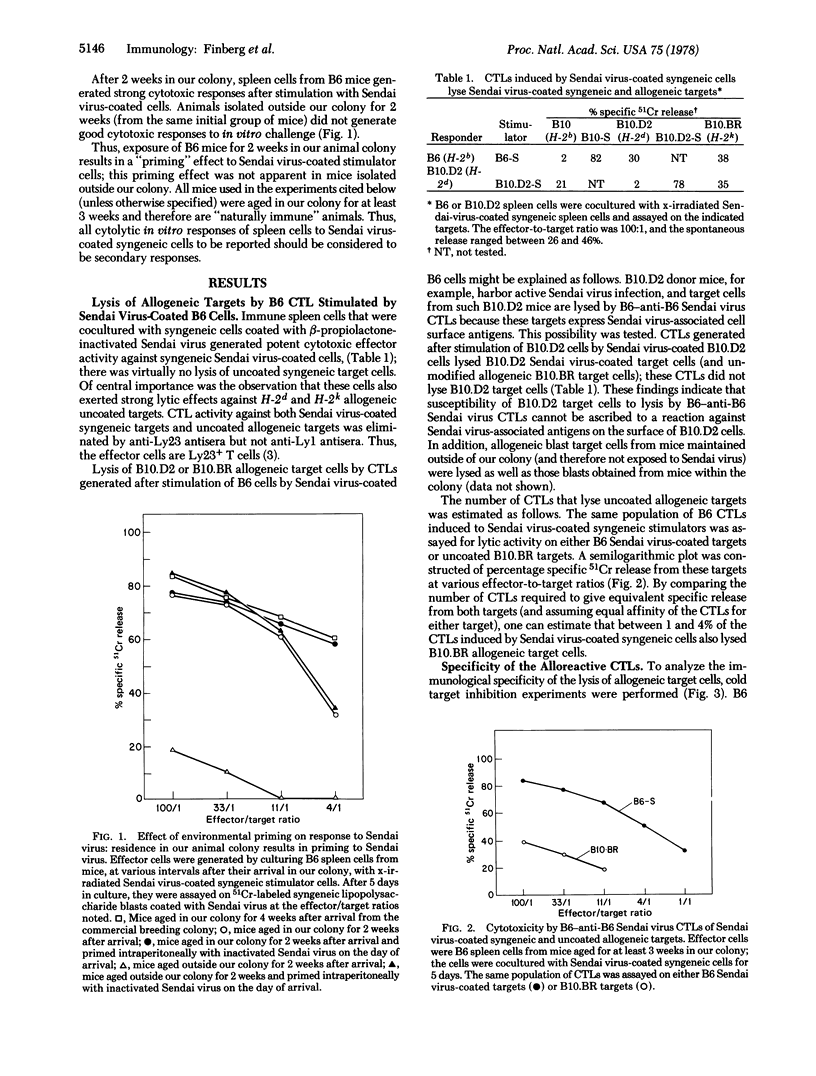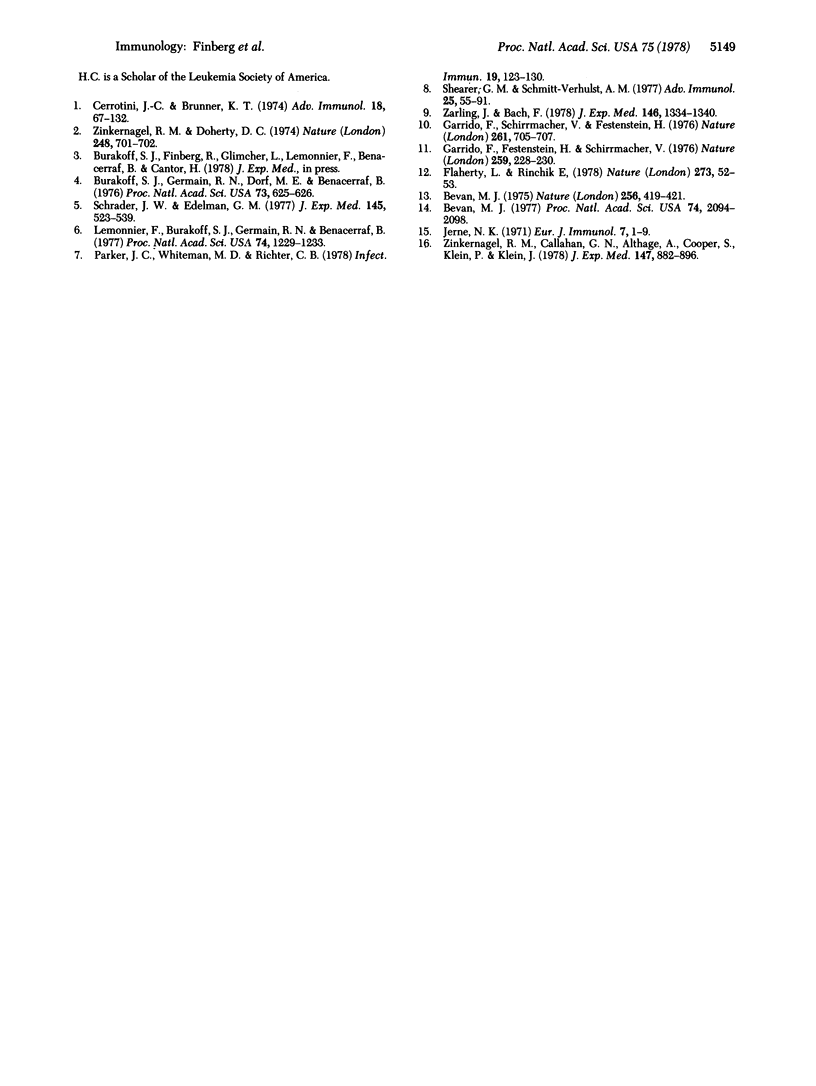Abstract
In vitro stimulation of spleen cells from mice immune to Sendai virus results in the generation of effector cells that lyse unmodified allogeneic target cells in addition to syngeneic cells modified by virus. These cells are immunologically specific because their lysis may be blocked by cold targets syngeneic to either the stimulator or the responder. These results support our proposal that the development of alloreactivity can be explained by the crossreactivity between modified self major histocompatibility complex antigens and alloantigens. We propose that exposure to autologous major histocompatibility complex antigens modified by foreign antigens in our environment results in the expansion of the pool of T cells that will respond to alloantigens sharing crossreactive determinants.
Full text
PDF




Selected References
These references are in PubMed. This may not be the complete list of references from this article.
- Bevan M. J. Interaction antigens detected by cytotoxic T cells with the major histocompatibility complex as modifier. Nature. 1975 Jul 31;256(5516):419–421. doi: 10.1038/256419a0. [DOI] [PubMed] [Google Scholar]
- Bevan M. J. Killer cells reactive to altered-self antigens can also be alloreactive. Proc Natl Acad Sci U S A. 1977 May;74(5):2094–2098. doi: 10.1073/pnas.74.5.2094. [DOI] [PMC free article] [PubMed] [Google Scholar]
- Burakoff S. J., Germain R. N., Dorf M. E., Benacerrah B. Inhibition of cell-mediated cytolysis of trinitrophenyl-derivatized target cells by alloantisera directed to the products of the K and D loci of the H-2 complex. Proc Natl Acad Sci U S A. 1976 Feb;73(2):625–629. doi: 10.1073/pnas.73.2.625. [DOI] [PMC free article] [PubMed] [Google Scholar]
- Cerottini J. C., Brunner K. T. Cell-mediated cytotoxicity, allograft rejection, and tumor immunity. Adv Immunol. 1974;18:67–132. doi: 10.1016/s0065-2776(08)60308-9. [DOI] [PubMed] [Google Scholar]
- Cytolytic thymus-derived lymphocytes specific for allogeneic stimulator cells crossreact with chemically modified syngeneic cells. Proc Natl Acad Sci U S A. 1977 Mar;74(3):1229–1233. doi: 10.1073/pnas.74.3.1229. [DOI] [PMC free article] [PubMed] [Google Scholar]
- Garrido F., Festenstein H., Schirrmacher V. Further evidence for depression of H-2 and Ia-like specificities of foreign haplotypes in mouse tumour cell lines. Nature. 1976 Jun 24;261(5562):705–707. doi: 10.1038/261705a0. [DOI] [PubMed] [Google Scholar]
- Garrido F., Schirrmacher V., Festenstein H. H-2-like specificities of foreign haplotypes appearing on a mouse sarcoma after vaccinia virus infection. Nature. 1976 Jan 22;259(5540):228–230. doi: 10.1038/259228a0. [DOI] [PubMed] [Google Scholar]
- Jerne N. K. The somatic generation of immune recognition. Eur J Immunol. 1971 Jan;1(1):1–9. doi: 10.1002/eji.1830010102. [DOI] [PubMed] [Google Scholar]
- Schrader J. W., Edelman G. M. Joint recognition by cytotoxic T cells of inactivated Sendai virus and products of the major histocompatibility complex. J Exp Med. 1977 Mar 1;145(3):523–539. doi: 10.1084/jem.145.3.523. [DOI] [PMC free article] [PubMed] [Google Scholar]
- Shearer G. M., Schmitt-Verhulst A. M. Major histocompatibility complex restricted cell-mediated immunity. Adv Immunol. 1977;25:55–91. doi: 10.1016/s0065-2776(08)60931-1. [DOI] [PubMed] [Google Scholar]
- Zarling J. M., Bach F. H. Sensitization of lymphocytes against pooled allogeneic cells. I. Generation of cytotoxicity against autologous human lymphoblastoid cell lines. J Exp Med. 1978 May 1;147(5):1334–1340. doi: 10.1084/jem.147.5.1334. [DOI] [PMC free article] [PubMed] [Google Scholar]
- Zinkernagel R. M., Callahan G. N., Althage A., Cooper S., Klein P. A., Klein J. On the thymus in the differentiation of "H-2 self-recognition" by T cells: evidence for dual recognition? J Exp Med. 1978 Mar 1;147(3):882–896. doi: 10.1084/jem.147.3.882. [DOI] [PMC free article] [PubMed] [Google Scholar]
- Zinkernagel R. M., Doherty P. C. Restriction of in vitro T cell-mediated cytotoxicity in lymphocytic choriomeningitis within a syngeneic or semiallogeneic system. Nature. 1974 Apr 19;248(5450):701–702. doi: 10.1038/248701a0. [DOI] [PubMed] [Google Scholar]


